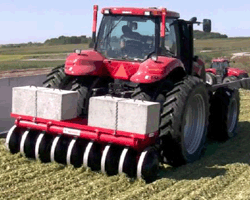
Does new equipment provide better packing? (Jon Urness)
 Jon Urness, Vita Plus national forage specialist
Jon Urness, Vita Plus national forage specialistAt every Vita Plus training session, meeting or other opportunity, we remind folks that, to achieve the best chance of a good silage fermentation, we need to start with a crop that is harvested at the proper moisture, maturity and particle size, then pack that feed to achieve high storage density, cover it to keep out oxygen and, finally, use the best inoculant we can get.
Missing the mark on any one of these points can foul the system, but if we don’t achieve high storage density, we’re going to be in trouble no matter what.
Low density almost guarantees an inefficient fermentation with losses at the front end of the process and, most likely, will cause big problems at feedout due to excessive exposure to oxygen and aerobic instability.
Critical factors to achieve high densities on forage piles and bunkers include weight and time of the packing tractor on the feed, operator technique (such as keeping packing layers thin), and of course moisture and particle size of the feed.
Some producers looking for an edge have tried mechanical rolling equipment that carries claims of greater density results.
 Recently, Dr. Rich Muck and Dr. Brian Holmes, researchers at the USDA Dairy Forage Research Center, did some testing of one those machines and concluded that a modest improvement in density can be achieved. Their test was done with the Agromatic Impact Silage Packer.
Recently, Dr. Rich Muck and Dr. Brian Holmes, researchers at the USDA Dairy Forage Research Center, did some testing of one those machines and concluded that a modest improvement in density can be achieved. Their test was done with the Agromatic Impact Silage Packer.
The USDA test was done on two bunkers of corn silage, each packed to a depth of about 12 feet. Similar 30,000-pound tractors were used for all tests and the comparison was done using a packing tractor and spreading tractor on the same bunker versus a spreading tractor and a packing tractor mounted with an Impact Packer. The weight of the Impact Packer added an additional 10,000 pounds.
The first bunker was layered with Shredlage® on the bottom half and conventionally processed corn silage on the upper half. Between this variable of feeds and some difficulty getting the Impact Packer unit set up and balanced properly on the three-point hitch, it was not easy to draw conclusions.
The second bunker was filled entirely with conventionally processed corn silage. After the Impact Packer was set up properly with less weight transferred to the tractor, more reliable data was collected. Subtle differences were noted at all depths of the bunker. The greatest improvement with the Impact Packer seemed to be from 4 to 6 feet from the top surface of the bunker and again in the bottom of the bunker.
Based on these experiments, Holmes and Muck concluded that the machine worked best when it was set up properly with most of the weight of the Impact Packer applied to the silage rather than to the packing tractor. The gain in dry matter density appeared to be 0.8 pounds per cubic foot of silage.
| Category: |
Equipment Forage Foundations Forage storage and management |

